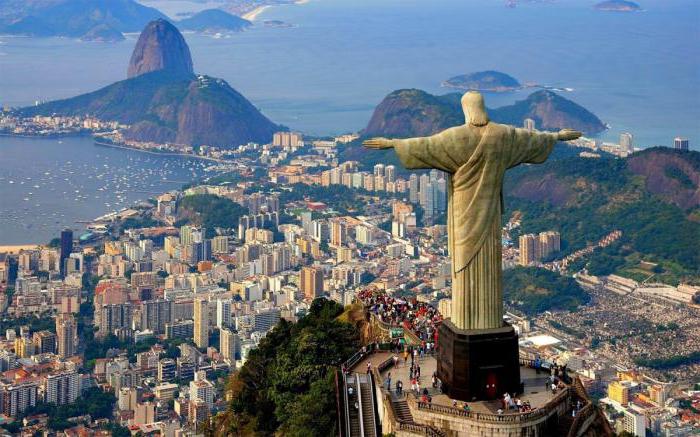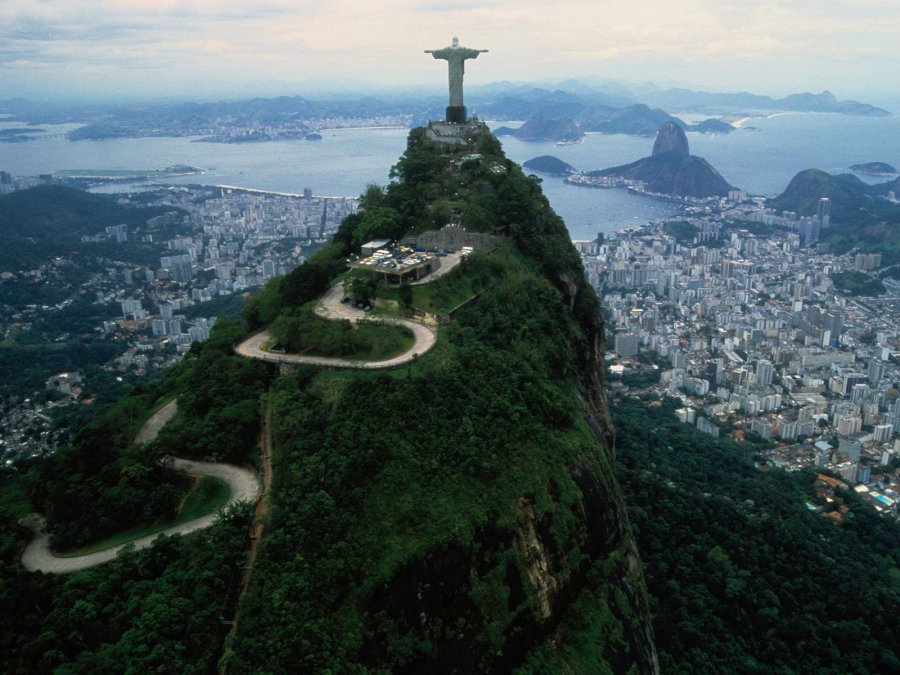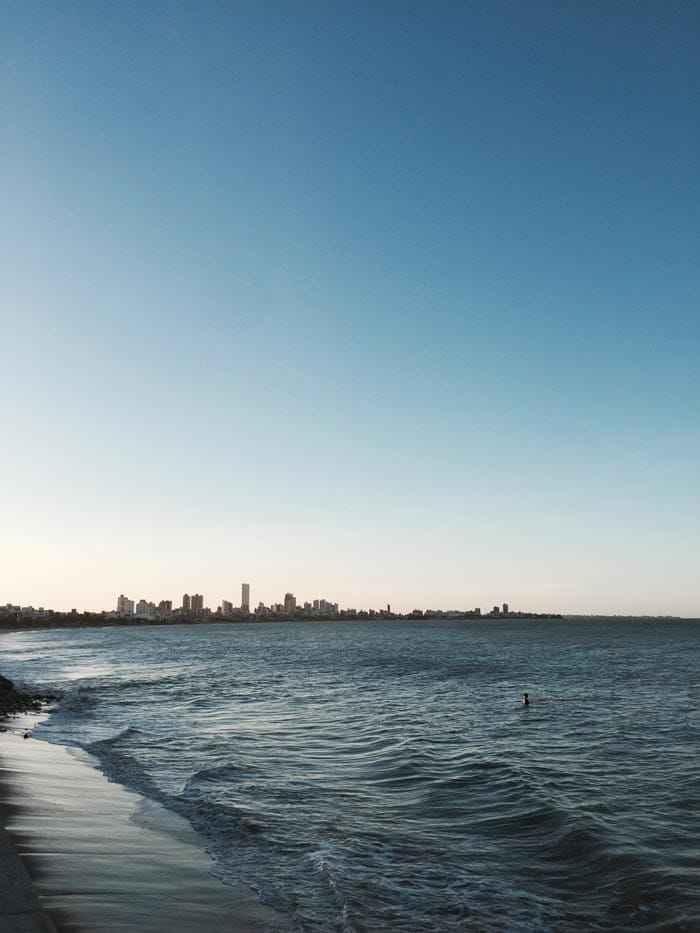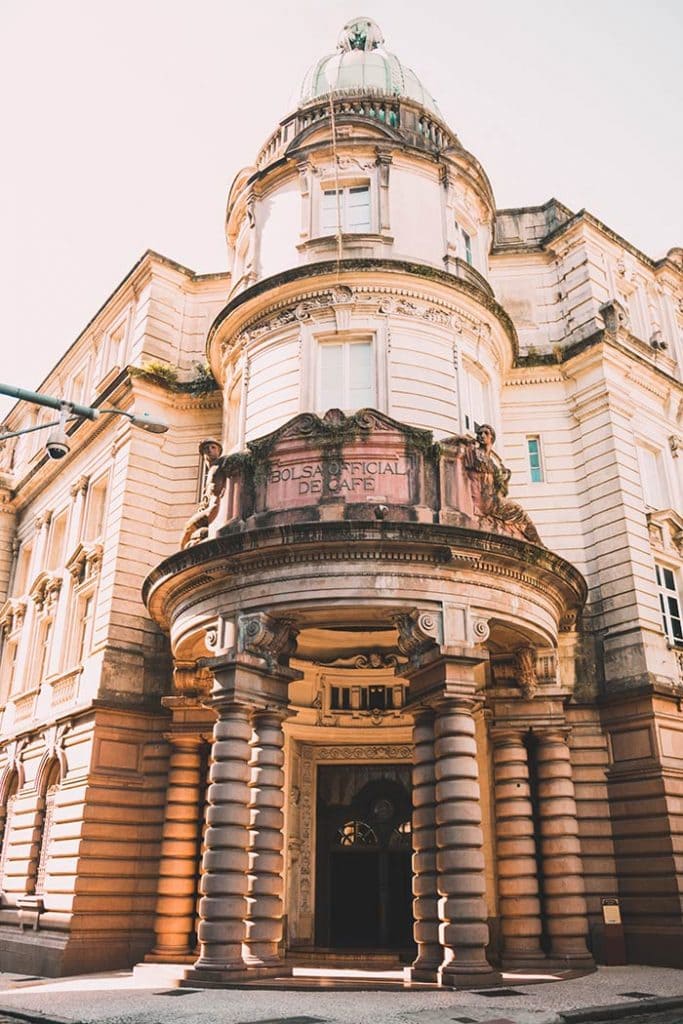Бразилия — туристический рай
Содержание:
- Несколько фактов о Бразилии
- Credits
- World Heritage site
- Facts about slavery in Brazil
- Brazilian geography
- References
- География
- Безопасность туристов
- Общая информация о Бразилии
- География Бразилии
- Brazilian achievements
- Interesting facts about Brazil
- Administrative divisions
- Brazil number ones
- Аренда авто в Бразилии
- Транспорт
- Geography
Несколько фактов о Бразилии
Brazil (официальное название страны – Федеративная Республика Бразилия) располагается на материке Южная Америка. Ее площадь составляет более 8500 тыс. квадратных километров, а протяженность сухопутных границ – 16 тысяч километров. Омываемая на востоке Атлантическим океаном страна делится на пять макрорегионов: центральный, северный, южный, центрально-западный, северо-восточный.
Государство состоит из 26 федеративных штатов и одного федерального округа, в котором находится столица. Федеративная Республика Бразилия включает в себя примерно четыре тысячи триста муниципалитетов, управляемых префектами.

Большое влияние на самобытную культуру оказала бывшая метрополия – Португалия, и государственным языком признан португальский.
Credits
New World Encyclopedia writers and editors rewrote and completed the Wikipedia article
in accordance with New World Encyclopedia standards. This article abides by terms of the Creative Commons CC-by-sa 3.0 License (CC-by-sa), which may be used and disseminated with proper attribution. Credit is due under the terms of this license that can reference both the New World Encyclopedia contributors and the selfless volunteer contributors of the Wikimedia Foundation. To cite this article click here for a list of acceptable citing formats.The history of earlier contributions by wikipedians is accessible to researchers here:
Brazil history
The history of this article since it was imported to New World Encyclopedia:
History of «Brazil»
Note: Some restrictions may apply to use of individual images which are separately licensed.
World Heritage site
The Brazilian capital is the only city in the world built in the twentieth century to be awarded by UNESCO, a United Nations agency since 1987, the status of being a World Heritage Site.
In order to be considered for World Heritage status, a site must fulfill one of ten standards for qualification. Brasilia fulfilled two:
- to represent a masterpiece of human creative genius
- to be an outstanding example of a type of building, architectural or technological ensemble or landscape which illustrates (a) significant stage(s) in human history
Created from nothing in the center of the country Brasilia is a landmark in the history of town planning, from the layout of the residential and administrative districts to the symmetry of the buildings themselves, which are designed to harmonize with the city’s overall design. The official buildings, in particular, are innovative and imaginative.
Facts about slavery in Brazil
Brazil was the country that imported the most African slaves
This disheartening fact about Brazil is still ignored by many people, while many others simply don’t know about it – the country imported by far the most slaves.
It’s estimated that about 12.5 million slaves were sent abroad, and 38.9% of all of them went to Brazil.
That’s somewhere around 4.8 million. Much more than the 2nd place British Caribbean which received about 2.3 million slaves.
Brazil was the last nation in the Americas to abolish slavery
As if having the most significant number of slaves wasn’t enough, Brazil was the last country in the Americas to abolish slavery in 1888.
After all the other countries in the western world and under significant pressure from Europe, Brazil finally abolished such horrific acts in the 19th-century.
Although this was a step toward equal rights for all races, it’s worth mentioning racism didn’t disappear from the country.

Facts about Brazil: 9% of the population is African descendant
Racism and slavery are touchy topics for the upper class in the country
Roughly 9% of the Brazilian population has African ancestry, and 46% is considered interracial, including Indigenous Brazilian, African, and European. We have ethnic groups from many regions worldwide, and we proudly say we’re a multicultural society.
See the slogan of this website, for example—experience diversity.
However, the economic inequality of blacks and mixed-race people in Brazil is alarming.
Many people claim the country is meritocratic and that racism doesn’t exist here; after all, Brazil is so multicultural, how could it be?
The reality isn’t pretty different, unfortunately. And many people, especially the upper classes of our society, simply deny talking about it.
However, more and more folks of all ethnicities feel suppressed by this. As a result, they are bringing up this and other touchy topics in the country, such as misogyny and the macho culture.
Editor’s note: The slogan of this website is “Experience Diversity” because my country is diverse, and I’m not only proud of it but I’m also fighting, together with fellow Brazilians, to make it equal for everybody.
Brazilian geography
Brazil is mostly a tropical country that has many geographical features in its territory, from desert to rainforest and mountain.
The highest mountain in Brazil is Neblina Peak, reaching 9,822 ft (2.994 m). This massive Brazil fact (pun intended) is a blast for adventure and hike lovers.
That’s because Neblina Peak is a unique and challenging hike that takes you to the limit before even you get to the mountain.
The whole trip includes a boat, 4×4 jeep, and trekking through the jungle to reach Brazil’s highest point. Totally worth it.
And while Brazil has many modern cities, colonial towns, pristine beaches, and breathtaking mountains, the second-most visited place in the country is the Iguazu Falls.
The entrance gate for most visitors is Rio de Janeiro, of course.
As for its borders, Brazil borders all countries in South America, except Chile and Ecuador.
References
- Alves, Maria Helena Moreira. State and Opposition in Military Brazil. Austin, TX: University of Texas Press, 1985. ISBN 0292775989
- Amann, Edmund, and Werner Baer. The Illusion of Stability the Brazilian Economy Under Cardoso. Urbana, IL: University of Illinois at Urbana-Champaign, 1999.
- Bellos, Alex. Futebol: The Brazilian Way of Life. New York: Bloomsbury, 2002. ISBN 1582342504
- Bethell, Leslie. Colonial Brazil. Cambridge: Cambridge University Press, 1987. ISBN 0521341272
- Costa, Cruz. A History of Ideas in Brazil; the Development of Philosophy in Brazil and the Evolution of National History. Berkeley: University of California Press, 1964.
- Fausto, Boris. A Concise History of Brazil. Cambridge Concise Histories. Cambridge: Cambridge University Press, 1999. ISBN 052156526X
- Furtado, Celso. The Economic Growth of Brazil, a Survey from Colonial to Modern Times. Berkeley: University of California Press, 1963.
- Leal, Victor Nunes. Coronelismo the Municipality and Representative Government in Brazil. Cambridge: Cambridge University Press, 1977. ISBN 0521214882
- Malathronas, John. Brazil Life, Blood and Soul. Summersdale Travel. Chichester, West Sussex, UK: Summersdale, 2003. ISBN 1423745272.
- Martínez-Lara, Javier. Building Democracy in Brazil the Politics of Constitutional Change, 1985-95. New York: St. Martin’s Press, 1996.
- Prado Júnior, Caio. The Colonial Background of Modern Brazil. Berkeley: University of California Press, 1967.
- Schneider, Ronald M. Brazil Culture and Politics in a new Industrial Powerhouse. Boulder, CO: Westview Press, 1996. ASIN B079ZBZJS6
- Skidmore, Thomas E. Black into White; Race and Nationality in Brazilian Thought. New York: Oxford University Press, 1974. ISBN 0822313200
- Wagley, Charles. An Introduction to Brazil. New York: Columbia University Press, 1963.
- The World Almanac and Book of Facts. New York: World Almanac Books, 2006. ISBN 0886879647
География

Бразилия расположена в Южной Америке и занимает площадь 8 547,4 тыс. кв. км. Большая часть территории находится в Южном полушарии.
Бразилия на севере граничит с заморским департаментом Франции Гвианой, Суринамом, Гайаной, Венесуэлой и Колумбией; на западе — с Перу; на юго-западе — с Боливией, Парагваем, Аргентиной и Уругваем. На востоке Бразилия омывается Атлантическим океаном. Длина береговой линии от границы с Гвианой до границы с Уругваем — 6840 км.
Основными чертами географии являются бассейн реки Амазонки и Бразильское плоскогорье или плато. Плато занимает большую часть юго-восточной половины страны. Высота плато от 300 до 900 метров, во многих местах его пересекают долины рек и невысокие горные цепи.
#BANNER#
Главные горные цепи Бразильского плато — Сиерра-да-Мантикейра, Сиерра-до-Мар и Сиерра-Жераль. Их высота обычно не превышает 1200 метров, однако отдельные вершины поднимаются на высоту более 2200 метров (Пика-да-Бандейра — 2890 метров и Недра-Аку — 2232 метров).
Крупнейшие реки — Амазонка, Мадейра, Тапажос, Риу-Негру, Парнаиба, Уругвай.
Бассейн Амазонки занимает более одной трети территории. Там преобладают равнины, а высота территории редко превышает 150 м. Большую часть бассейна занимают болота и затопляемые поймы, а также густые джунгли.
На севере Амазонского бассейна находится горная цепь — Гвианское нагорье — состоящая из Сиерра-Тумукумаке (высота до 850 м), Сиерра-Акари (до 600 м) и Сиерра-Парима (до 1500 м). На границе с Венесуэлой находится высочайшая точка Бразилии — гора Пика-да-Неблина (3014 м).
Совершенно особая природная область Бразилии Пантанал (порт. «болотистая местность») Она расположена в верховьях реки Парагвай, почти в центре Южной Америки. Это обширная тектоническая впадина, с севера, востока и юго-востока ограниченная обрывами Бразильского плоскогорья, а с запада — склонами Боливийского нагорья. Быстрые горные речки, стекающие с Бразильского плоскогорья, замедляют на низменной равнине свой бег и широко разливаются в период летних дождей, затопляя практически всю впадину. В зимнюю засуху Пантанал — это мозаика болот, озёр и едва различимых блуждающих русел рек, солончаков, песчаных отмелей и травянистых участков.
Безопасность туристов
Водопроводную воду в Бразилии пить нельзя, зато можно и нужно пользоваться солнцезащитным кремом. Также туристам необходимо быть максимально внимательными на улицах с деньгами и ценностями, чтобы избежать нападения хулиганов.
Купание на большинстве пляжей страны имеет одну неприятную особенность: сильные океанские течения идут вдоль берега, представляя определенную опасность для незнакомого с характером местных вод купальщика и формируя опасные «стоячие» волны, создающие мощную прибойную зону.
- На каком языке можно общаться в Бразилии
- Нужно ли делать прививки от гепатита и профилактику малярии для поездки в Бразилию
Общая информация о Бразилии
Официальное название: Федеративная Республика Бразилия
Столица: Бразилиа
Площадь территории: 8 547,4 тыс. кв. км
Общее население: 201,1 млн. чел.
Административное деление: Государство разделено на 23 штата, один столичный округ и 3 федеральных территории.
Форма правления: Республика, с федеративным государственным устройством.
Глава государства: Президент, избираемый на 5 лет.
Состав населения: Этнические группы: белые — 53.9 %(португальцы — 20 %; итальянцы — 14 %; испанцы — 8 %; немцы — 6,6 %; арабы — 5,3 %); мулаты — 38,5 %; чёрные — 6,2 %; азиаты — 0,5 % ( японцы и пр.); индейцы — 0,43 % (тупи-гуарани, же, араваки, карибы, пано и др.).
Так же есть самбо (афро-индейцы) и пардо (коричневые) — их количество точно не известно.
Государственный язык: португальский. Также используются испанский, немецкий, итальянский, японский , украинский , английский и индейские языки.
Религия: 73,6% — католики, 15,4% — протестанты, 1,3% — спиритуалисты, 0,3% — банту/вуду, 7,4% — атеисты, 2% — другие.
Интернет-домен: .br
Напряжение в электросети: ~127 В/220 В, 60 Гц
Телефонный код страны: +55
Штрих-код страны: 789-790
География Бразилии
Бразилия располагается в Южной Америке. На севере Бразилия граничит с Суринамом, Венесуэлой, Гайаной и Французской Гвианой, на северо-западе – с Колумбией, на западе – с Перу и Боливией, на юге – с Уругваем, а на юго-западе – с Аргентиной и Парагваем. На востоке страна омывается Атлантическим океаном. Общая площадь этого государства – 8 514 877 кв. км., а общая длина государственной границы – 14 691 км.
Территория Бразилии очень разнообразна – там есть низменности, равнины, холмы, горы. На севере находится Амазонская низменность, преходящая в Гвианское плоскогорье, а на юге — Бразильское плоскогорье. Самая высокая местная вершина – пик Неблина, чья высота достигает 2 994 метров.
Основные бразильские реки – Амазонка, Парана (и ее главный приток Игуасу), Негро, Сан-Франциско и Мадейра.
Brazilian achievements
A high-school student from Pará created a brick made of açai seeds
If you have ever had açai, chances are you probably had açai from Pará.
That’s because 90% of all açai comes from Pará, but only 4% of this Brazilian fruit is used. The rest is waste.
And so much waste was causing an environmental issue in the region.
However, the high school student Francielly Rodrigues Barbosa, 18 years old, developed bricks from açai seeds.
With her project, Francielly helped not only the environment but also the local community. That’s because she created a low-cost alternative for people whose house walls were in bad condition.
Brazilian agronomist, Johanna Dobereiner identified specific types of bacterias that helped the nutrition of non-leguminous crop plants through nitrogen fixation in the roots.
Her achievements allowed for less environmental impact and the cheaper production of soybean. Nowadays, Brazil is one of the biggest exporters of soy.

Go, girls!
A Brazilian physician discovered Chagas disease
Carlos Chagas, a physician, born in Minas Gerais, discovered in 1909 the Chagas disease, which is named after him.
The disease is more common in rural areas of Latin America.
Here are some other exciting things about Brazil and Brazilians.
- In 1903, Vital Brazil discovered the polyvalent anti-ophitic serum, which is used to treat bites from poisonous snakes.
- In 1932, José Braz Araripe developed the automatic transmission in cars using hydraulic fluid.
- In 1936, Manuel Dias Abreu invented the rapid radiography of the lungs for screening tuberculosis.
- In 1945, brigadeiro.
- In 1959, Therezinha Beatriz Alves invented the rice colander after clogging her sink multiple times.
- In 1972, Andreas Pavel invented the walkman. At the time, it was called a stereo belt.
- In 1978, Marcos dos Mares Guias discovered that genetically engineered, synthetic “human” insulin could be produced using E. coli bacteria.
- In 1996, Carlos Eduardo Lamboglia invented the electronic panel used in soccer games to indicate assisted substitutions.
- In 2000, Aron de Andrade invented an artificial heart which is connected to the natural heart and powered by an electric motor. This is the world’s cheapest artificial heart model, and the only one that doesn’t require the extraction of the organ. It weighs only 700g.
- In 2004, Eduardo Saverin co-founded .
- In 2010, Michael Krieger co-founded Instagram.
Interesting facts about Brazil
Yes, this is a pretty interesting fact about Brazil, let alone the whole continent.
João Pessoa is the easternmost city in the Americas. The city is the capital of Paraíba state and famous for having abundant green areas.
Will you resist watching the sunset here?

Fun fact about Brazil: the sun rises first in João Pessoa
Brasília is not Brazil’s first capital
First things first. Plenty of readers have asked me if Brazil’s capital is Rio de Janeiro, but it’s not.
Well, to comfort you a little bit, know that the city was once the capital of the country.
In fact, Brazil has had three capitals: Salvador, Rio de Janeiro, and the current one, Brasília.
There is a replica of the 14th-century Japanese temple Kinkaku-ji in Brazil
With a massive Japanese community, it doesn’t come as a surprise that São Paulo has a replica of one of Japan’s most significant temples, right?
A little over an hour’s drive from the city center, the town of Itapecerica da Serra is home to a beautiful cinerarium.
This cinerarium is based in the Japanese Kinkaku-ji temple’s replica surrounded by a gorgeous garden. This is a great day trip from SP.
In Kyoto, this temple is covered in gold leaf; hence, the name Kinkaku-ji, which means Golden Pavilion in English.
Administrative divisions
Politically, Brazil is a federation of twenty-six states and one federal district.
The national territory was divided in 1969, into five main regions: North, Northeast, Central-West, Southeast, and South.
The North covers 45.27 percent of the surface of Brazil and has the lowest number of inhabitants. With the exception of Manaus, which hosts a tax-free industrial zone, and Belém, the biggest metropolitan area of the region, it is fairly unindustrialized and undeveloped. It accommodates most of the rainforest vegetation of the world and many indigenous tribes.
The Northeast, inhabited by about 30 percent of Brazil’s population, is culturally diverse, with roots set in the Portuguese colonial period and in Amerindian and Afro-Brazilian elements. It is also the poorest region of Brazil and suffers from long periods of dry climate. The largest cities are Salvador, Recife, and Fortaleza.
The Central-West region has low demographic density when compared to the other regions, mostly because part of its territory is covered by the world’s largest marshlands area, the Pantanal, as well as a small part of the Amazon rainforest in the northwest. Much of the region is covered by Cerrado, the largest savanna in the world. The Central-West region contributes significantly toward agriculture. The largest cities of this region are: Brasília (the capital), Goiânia, Campo Grande, Cuiabá, Anápolis, Dourados, Rondonópolis, and Corumbá.
The Southeast region is the richest and most densely populated. It has more inhabitants than any other South American country and hosts one of the largest megalopolises of the world. The main cities are the country’s two largest: São Paulo and Rio de Janeiro. The region is very diverse, including the major business center of São Paulo, the historical cities of Minas Gerais and its capital Belo Horizonte, the beaches of Rio de Janeiro, and the coast of Espírito Santo.
The South is the wealthiest by GDP per capita and has the highest standard of living in the country. It is also the coldest region of Brazil, with occasional occurrences of frost and snow in some of the higher altitude areas. It has been settled by European immigrants, mainly of Italian, German, Portuguese, and Slavic ancestry, and has clearly been influenced by these cultures. The largest cities in this region are Curitiba, Porto Alegre, Florianópolis, Londrina, Caxias do Sul, and Joinville.
Brazil number ones
São Paulo is the largest city in the southern hemisphere
Brazil’s vibrant financial center, São Paulo metropolitan area, has about 21 million residents, while the city has approximately 12 million.
No wonder people call it the New York of South America. São Paulo is a massive city.
Brazil has more animal and plant species than any other country in the world
There’s a consensus in the biology world that Brazil is the most biodiverse country on the planet and rightly so because Brazil has the most known plants, amphibians, freshwater fish, and mammals.
Brazil has two biodiversity hotspots (the Atlantic Forest and savanna, known as cerrado), six terrestrial biomes, and three large marine ecosystems.
At least 103,870 animal species and 43,020 plant species are currently known in the country, comprising 70% of the world’s cataloged animal and plant species, according to Biofin.
Brazil has been the largest producer of coffee for the last 150 years
If you’re a coffee drinker, odds are you drank Brazilian coffee this year.
That’s because Brazil is by far the world’s largest producer and exporter of coffee, accounting for 30% of the world’s production.

Brazil facts: The country has been the largest producer of coffee for the last 150 years
Аренда авто в Бразилии
Для аренды автомобиля необходимо наличие международных водительских прав и кредитной карты. Пункты проката находятся, как правило, около крупных гостиниц и в аэропортах (работают они обычно с 9:00 до 16:00, а в аэропортах — круглосуточно). При аренде автомобиля оформляется страховка из расчета примерно 10-13 USD в день, а также взимается денежный залог (при наличии кредитной карты он не требуется). Местные фирмы обычно берут арендную плату в среднем на 10 % меньше, чем международные, но машины у них, как правило, постарше, и не всегда можно возвратить автомобиль в другом городе. Выезжать за пределы Бразилии на арендованном автомобиле запрещено.
Самая низкая цена аренды авто в местоположении Бразилиа аэропорт.
Мы просмотрели предложения от ВЕДУЩИХ компаний и хотим предложить вам отличные варианты аренды.
от
RUB 1809
в день

Смотреть больше
Транспорт
Автобусы, на которых перемещается между городами местное население, бывают нескольких уровней комфорта. Самые удобные и дорогие называются leito, вместо кресел в них стоят настоящие кровати. Ночные спальные автобусы надо бронировать минимум за день (кроме линии Рио — Сан-Паулу, по которой они курсируют каждые полчаса). На дальние расстояния лучше летать самолетом (к примеру, автобус из Салвадора в Рио идет 36 часов). Большая страна Бразилия имеет густую сеть внутренних авиалиний, связывающих между собой практически все крупные населенные пункты.
По городам можно передвигаться на такси (по ценам, приближающимся к европейским, но при отнюдь не европейских размерах некоторых городов — в первую очередь, Сан-Паулу) и автобусах. В Рио и Сан-Паулу также есть метро.
Во многих внутренних и прибрежных районах огромную долю перевозок осуществляет речной и морской транспорт. Многочисленные катера, паромы, каботажные суда и просто моторные лодки — основной транспорт в Амазонии.
Geography
Bounded by the Atlantic Ocean on the east, Brazil has a coastline of over 7,367 kilometers. It borders Venezuela, Suriname, Guyana, and French Guiana to the north, Uruguay to the south, Argentina and Paraguay to the southwest, Bolivia and Peru to the west, and Colombia to the northwest. Numerous archipelagos are part of the Brazilian territory, such as Penedos de São Pedro e São Paulo, Fernando de Noronha, Trindade e Martim Vaz, and Atol das Rocas.
Brazil is traversed by the Equator and Tropic of Capricorn and is home to varied fauna and flora, as well as extensive natural resources.
The Amazon rainforest.
Brazilian topography is diverse, including hills, mountains, plains, highlands, scrublands, savannas, rainforests, and a long coastline. The extensive low-lying Amazon rainforest covers most of Brazil’s terrain in the north; small hills and low mountains occupy the south. Along the Atlantic coast there are several mountain ranges, with altitudes of roughly 9,500 feet (2,900 m). The highest peak is the 9,735 foot (3,014 m) Pico da Neblina (Misty Peak) in Guiana’s highlands. Major rivers include the Amazon, the largest river in terms of volume of water and the second-longest in the world; the Paraná and its major tributary, the Iguaçu River, where the Iguaçu Falls are located; as well as the Negro, São Francisco, Xingu, Madeira, and Tapajós rivers.
Climate
The Iguazu Falls
Brazil’s climate has little seasonal variation, since 90 percent of the country is located within the tropics. However, the climate varies considerably from the mostly tropical north (the equator traverses the mouth of the Amazon) to temperate zones below the Tropic of Capricorn, which crosses the country at the latitude of the city of São Paulo. Brazil has five climatic regions: Equatorial, tropical, semiarid, highland tropical, and subtropical.
Temperatures along the equator are high, but southern Brazil has subtropical temperate weather, normally experiencing frost in the winter (June-August), and occasional snow in the mountainous areas, such as Rio Grande do Sul and Santa Catarina. Temperatures in the cities of São Paulo and Brasília are moderate because of their altitude of approximately 3,000 feet (1,000 m). Rio de Janeiro and Salvador, located on the coast, have warm climates.
Precipitation levels also vary widely, being higher in the humid Amazon Basin and lower in the somewhat arid landscapes of the northeast. The majority of Brazil has moderate rainfall, with most of it falling in the summer (between December and April), south of the Equator. The Amazon region is notoriously humid, with rainfall of more than 2,000 millimeters per year, getting as high as 3,000 millimeters in parts of the western Amazon and near Belém. Despite high annual precipitation, the Amazon rainforest has a three-to-five month dry season.
Environment
The Toco Toucan is a typical animal of the Brazilian rainforest.
Brazil’s large area comprises different ecosystems, which together sustain some of the world’s greatest biodiversity. Because of the country’s intense economic and demographic growth, Brazil’s ability to protect its environmental habitats has increasingly come under threat. Extensive logging in the nation’s forests, particularly the Amazon, destroys areas the size of a small country each year, and potentially a diverse variety of plants and animals. Between 2002 and 2006, an area of the Amazon rainforest equivalent in size to the U.S. state of South Carolina was completely decimated, for the purposes of raising cattle and logging. By 2020, it is estimated, at least 50 percent of the species in Brazil may become extinct.
The Pantanal area of Brazil is considered by many to be the world’s largest, freshwater, wetland system. It is one of the most pristine and biologically rich environments on the planet. It also provides many economic benefits, including offering a huge area for water purification and groundwater discharge and recharge, climate stabilization, water supply, flood abatement, and an extensive, transport system, among numerous other important functions.
There is a general consensus that Brazil has the highest number of both terrestrial vertebrates and invertebrates of any single country in the world. Also, Brazil has the highest primate diversity, the highest number of mammals, the second highest number of amphibians and butterflies, the third highest number of birds, and fifth highest number of reptiles. There is a high number of endangered species, many of them living in threatened habitats such as the Atlantic forest.